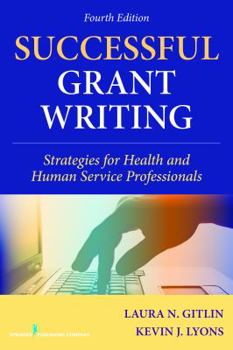Successful Grant Writing: Strategies for Health and Human Service Professionals
Select Format
Select Condition 
Book Overview
This book is easy to read and understand. It is a great resource for individuals wishing to write grants. I have not seen another book that is this comprehensive and user-friendly. Score: 92, 4 Stars.--Michalene A. King, PhD, RN, CNE in Doody's Medical Reviews
This fully updated and revised edition of a classic guide to grant writing for health and human service professionals reflects the two major changes in the field: new NIH application processes and an increased emphasis on interprofessional and team approaches to science. New case examples reflect grant writing strategies for a great variety of health and human service professions, and the text includes an enhanced focus on online methods for organizing grant submissions. A new section on special considerations for submitting grants addresses specific types of research including mixed methods, behavioral intervention research, secondary analyses, translational research, and comparative effectiveness studies. The new chapter on common writing challenges and solutions provides examples of strong and weak statements and highlights the importance of writing with precision. Additionally, this new edition provides an expanded section on post-award requirements and links to NIH videos about grant writing.
Written for individuals in both academic and practice settings, the guide addresses, step-by-step, the fundamental principles for effectively securing funding. It is the only book to provide grant-writing information that encompasses many disciplines and to focus on building a research career with grant writing as a step-wise process. It provides detailed, time-tested strategies for building an investigative team, highlights the challenges of collaboration, and describes how to determine the expertise needed for a team and the roles of co-investigators. The book addresses the needs of both novice and more experienced researchers.
New to the Fourth Edition:
Reflects recent changes to the field including an emphasis on interprofessional approaches to science and new NIH application processes Offers additional case examples relevant to social work, nursing, psychology, rehabilitation, and occupational, physical, and speech therapies Provides links to NIH websites containing videos on grant writing Includes chapter opener objectives Expands section on post-award requirements Focuses on electronic mechanisms for organizing grant submissions including software such as RefWorks and google alerts Enlarges appendices to include charts, graphics, grant application samples and Aims page samples full of errors with answers providedRelated Subjects
Business Business & Finance Business & Investing Business Writing College & University Economics Education & Reference Financial Aid General Industries & Professions Medical Medical Books Medicine Medicine & Health Sciences Nonprofit Organizations & Charities Political Science Politics & Government Politics & Social Sciences Public Affairs & Policy Public Policy Reference Research Skills Social Science Social Sciences Social Services & Welfare Social Work Test Prep & Study Guides Textbooks





